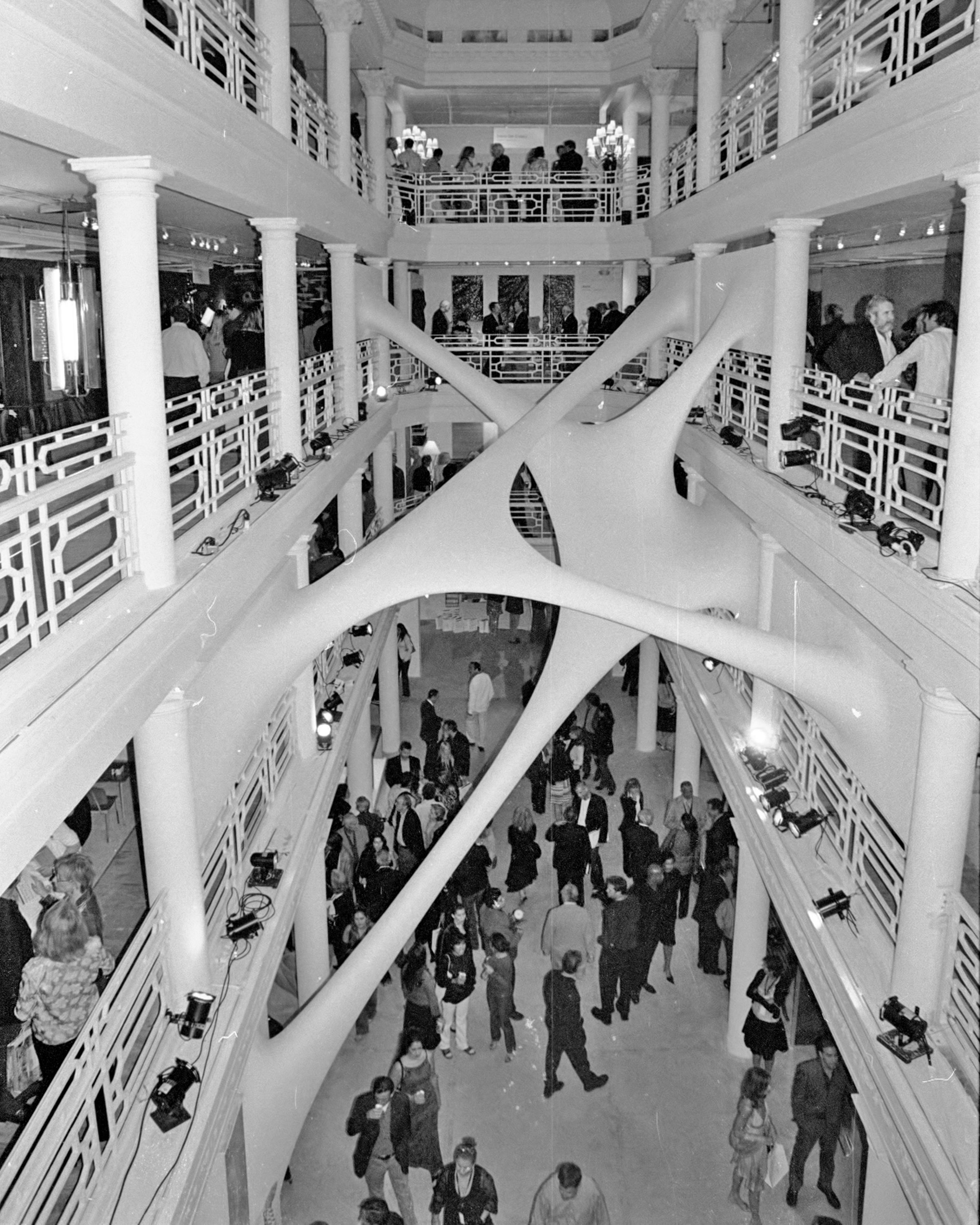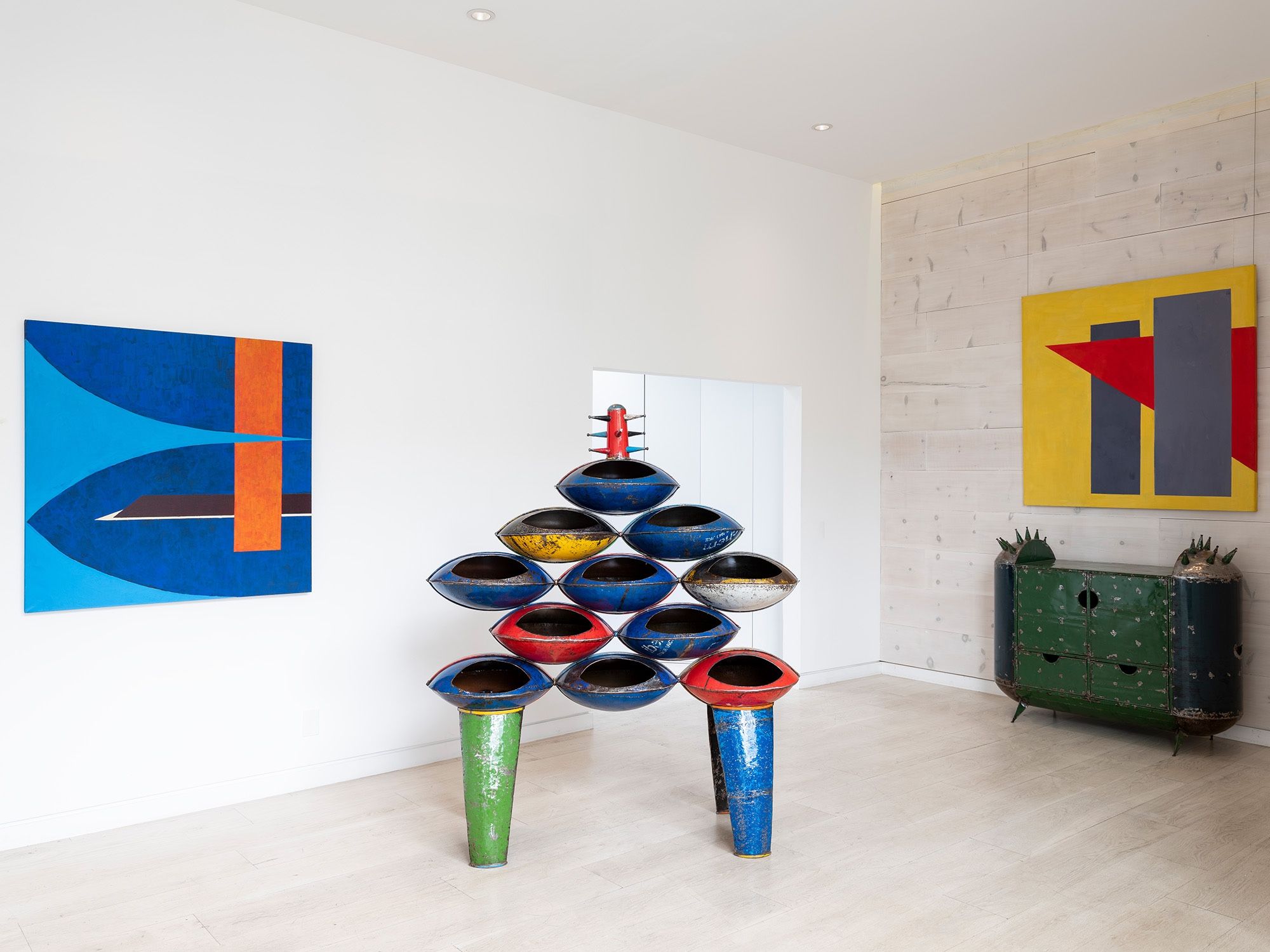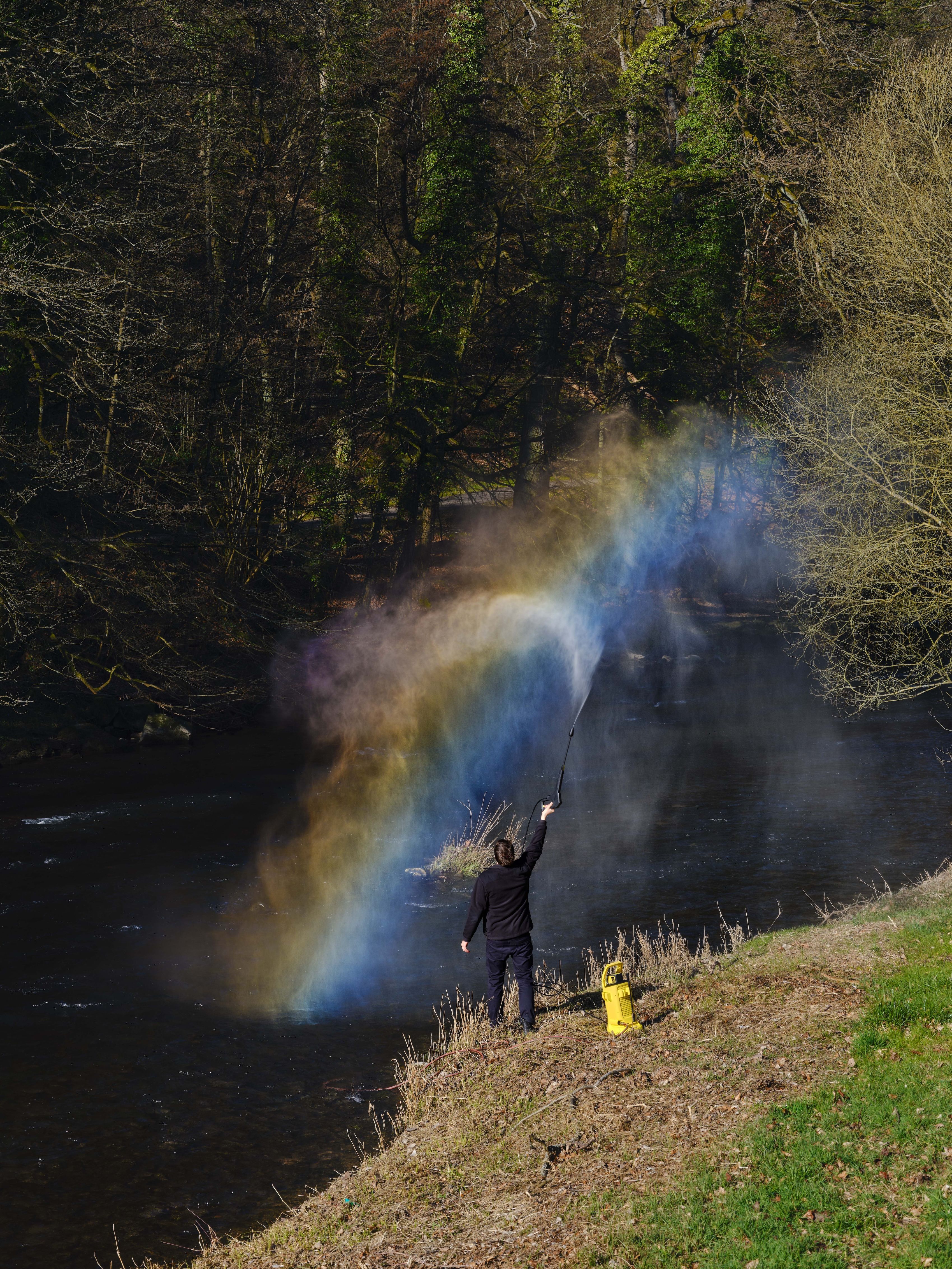IN THE MIX APRIL 14 2022
by Design Miami
Design world luminaries share fond memories of iconic New York design gallery MOSS
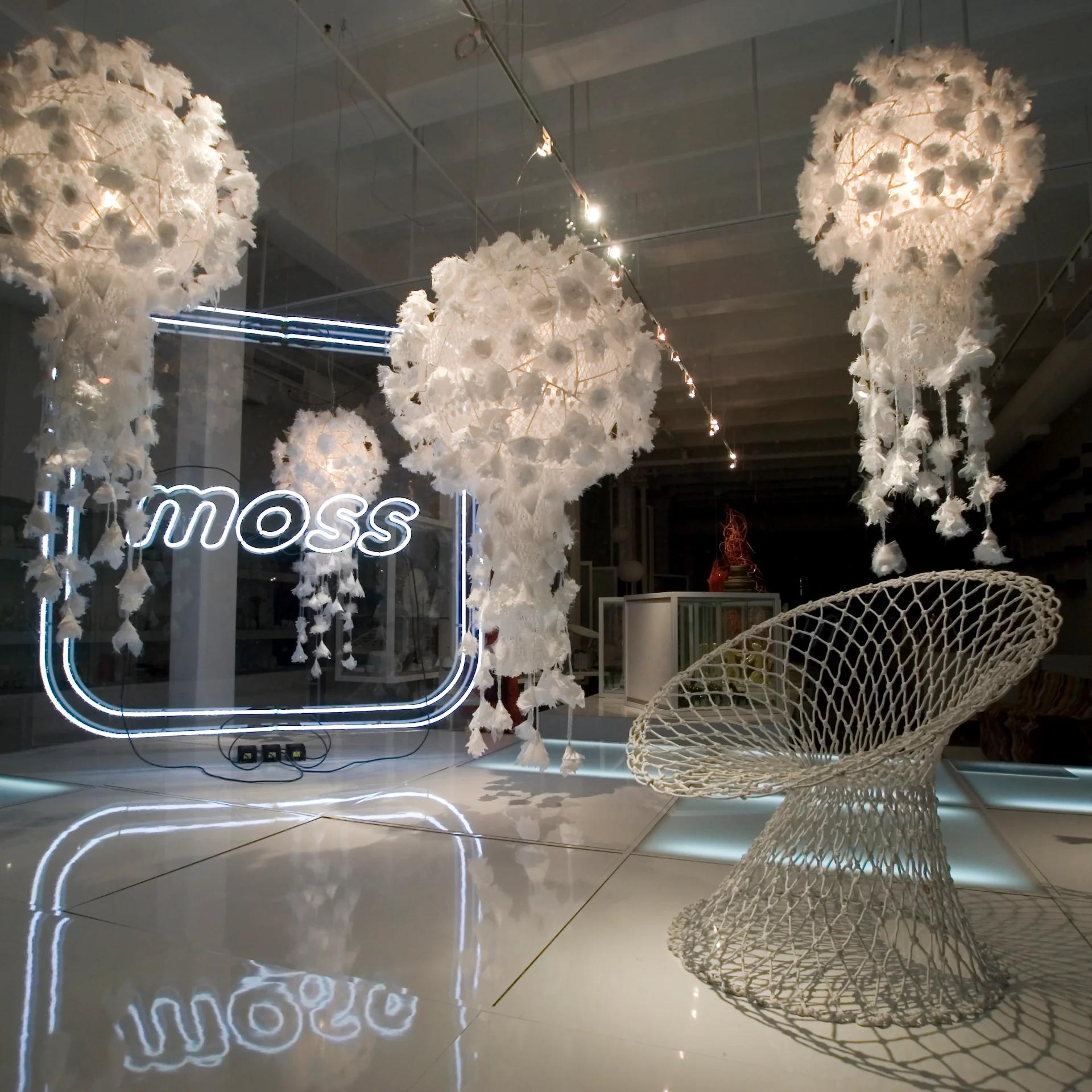
A VIEW INTO MOSS AT NIGHT, DECEMBER 21, 2009, FEATURING MARCEL WANDERS' FISHNET CHAIR
Photo © Dave Pinter via Flickr
To celebrate the launch of our latest special collection, Design Miami/ x MOSS, we’re taking a stroll down memory lane. Launched on Greene Street in Manhattan in 1994 by Murray Moss and Franklin Getchell, MOSS was much more than a design gallery. It was a museum-like retail phenomenon that played a defining role in 21st-century design culture at a time when collectible design as a category of contemporary creativity was just taking off. Although the doors closed a decade ago, Murray and Franklin’s vision for MOSS left an indelible imprint on what is deemed collection worthy even to this day.
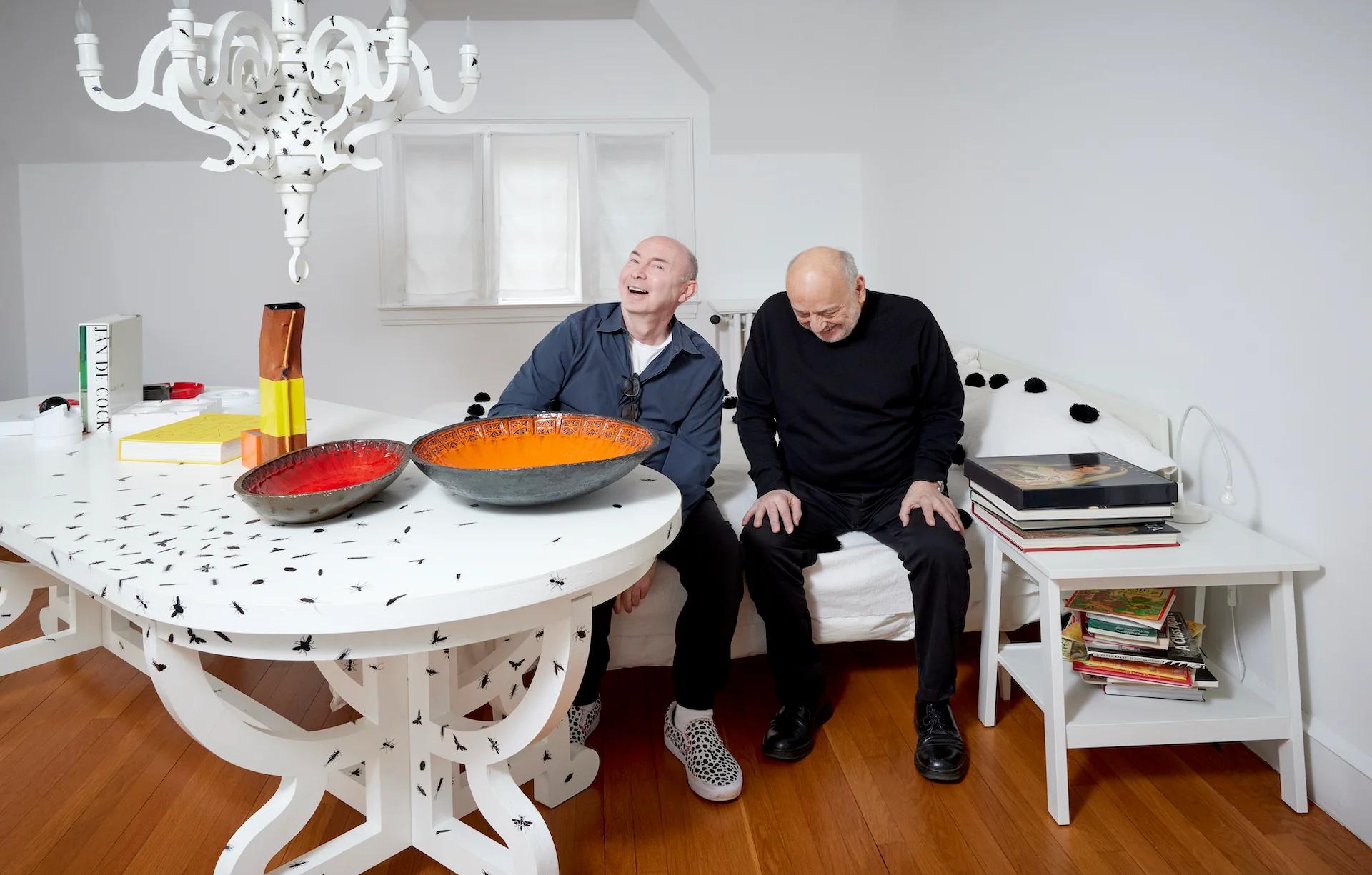
MURRAY MOSS AND FRANKLIN GETCHELL AT HOME, SURROUNDED BY SOME OF THE DESIGNS ONCE OFFERED AT MOSS
Photo © Erin Williams for Design Miami/
For those who never had the chance to visit MOSS, you really missed out. From the inventive window displays and imposing array of glass vitrines full of meticulously displayed objects, to the revolving program of thematic exhibitions, seasonal promotions, and rising-star talents, MOSS was one of a kind. For design lovers—who often stood in long lines to attend an opening—time spent at MOSS was a reliably joyful and edifying experience. For designers lucky enough to have their work exhibited there, it was a game changer, a springboard to fame.
Wanting to relive a bit of that magic, we reached out to some of those who were there for some of MOSS’s greatest moments, from designers who were represented by MOSS to staff members, editors, and shoppers who contributed to the buzz. Here’s what MOSS means to them…
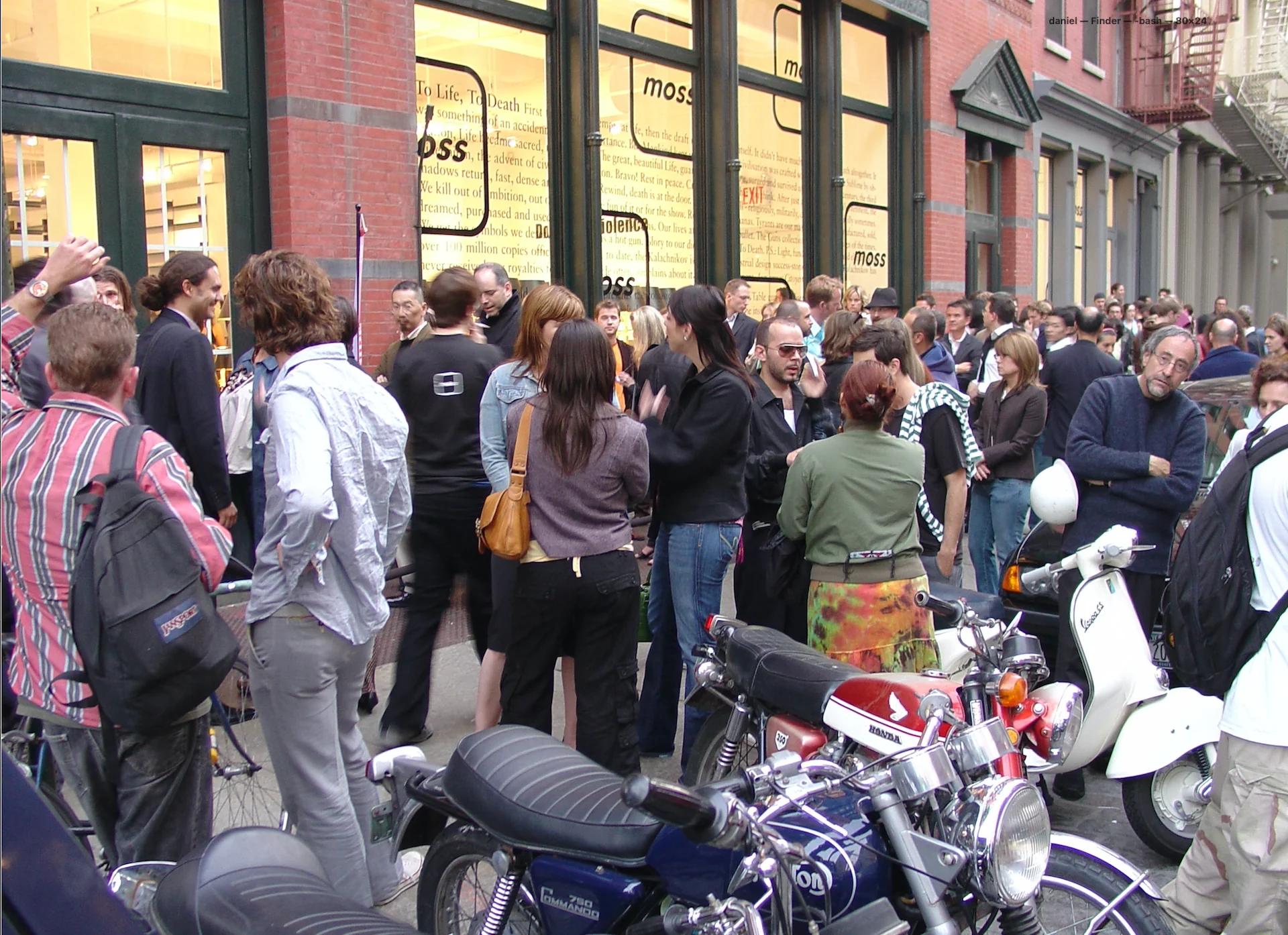
CROWD WAITING TO GET IN TO A MOSS OPENING
Photo © Franklin Getchell
Alexandra Lange: Design Critic, Author of Meet Me by the Fountain, and Former MOSS client
MOSS was a template for being a grown-up. The style of the goods but also the style of the store (minus the do not touch signs). To me, it said you can love white plates and also kid-like plastic, old-fashioned fancy China, and a bottle opener that lives in the junk drawer (though the drawer itself should be sleek). I window-shopped there more than at any Soho fashion boutique, and it felt like a rite of passage when I finally registered at MOSS for my wedding. Needless to say my actual house looks nothing like the store, but all the things I have from Moss look just fine anyway.
Brent Dzekciorius: Founder and Director of DZEK, Former Specialist for MOSS
MOSS gave me the design education that I was desperately looking for but didn’t know where to find. This was the only place in the world where you could get hands-on experience with exquisite mouth-blown Lobmeyr glassware, iconic Vitsoe 606 shelving by Dieter Rams, and unique works that Gaetano Pesce decided to bring down in his Santa sack that afternoon. Boundaries didn’t exist between those walls—and it was thrilling.
Constantin Boym: Founder of Boym Partners, Designer represented by MOSS
Murray Moss raised the bar for American design a few notches. The concept of quality—pretty vague for most product designers—came into clear focus in the brilliant vitrines of his store. Like a museum, it was a place to learn, to see, and to get inspired.
Dung Ngo: Design Consultant, Publisher, and Editor of the MOSS autobiography Please Do Not Touch (Rizzoli, 2018)
It might be a bit of a cliché to say, but MOSS was not about money—it was all about taste. That's not to say that there weren't numerous items that cost more than your new car. Their motto, "Please Do Not Touch," was only slightly ironic. On my first visit, a year or two after MOSS opened, I bought several Christopher Dresser bowls, newly rendered in colorful plastic by Alessi, priced around $20 each. Each piece was carefully wrapped as if it was a diamond engagement ring from Tiffany, then placed in a clear shopping bag for all to see. And seen they were—for the rest of the day, I received many approving looks and a few comments from fellow-shoppers and those in-the-know. MOSS was the most inclusive exclusive club I have ever belonged to.
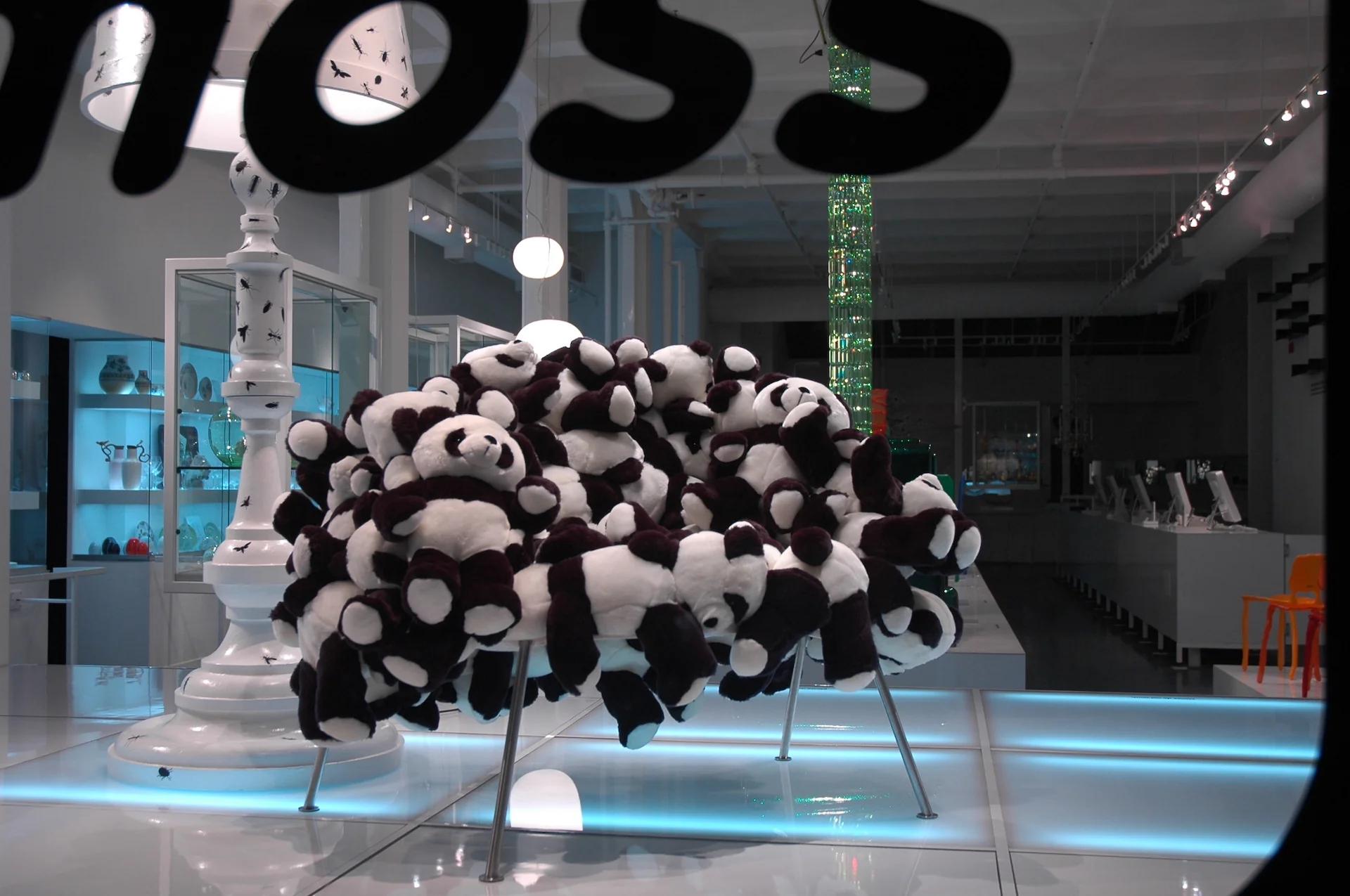
A VIEW INTO MOSS AT NIGHT, OCTOBER 2, 2007, FEATURING THE CAMPANA BROTHERS' PANDA CHAIR
Photo © Gilad Lotan via Flickr
Fernando Campana: Founder of Estudio Campana, Designer represented by MOSS
MOSS was more than a gallery, it was a mini museum that offered many learning opportunities thanks to the careful curation. We had the chance to work closely with Franklin and Murray on a few occasions, including the Campane di Campana installation, and they were truly memorable experiences.
Gaetano Pesce: Architect-Designer, Represented by MOSS
Murray Moss, with his vigorous intelligence revealed to the American public the cultural importance of Design. If we had governors who were cultured, they would give Murray recognition for raising the public's cultural level.
Harry Allen: Founder of Harry Allen Design, Designer of MOSS interior
Murray saw my first furniture collection and hired me to design the store. He was always strong of vision—and that vision became one of the most influential design stores ever. It was certainly an education for me.
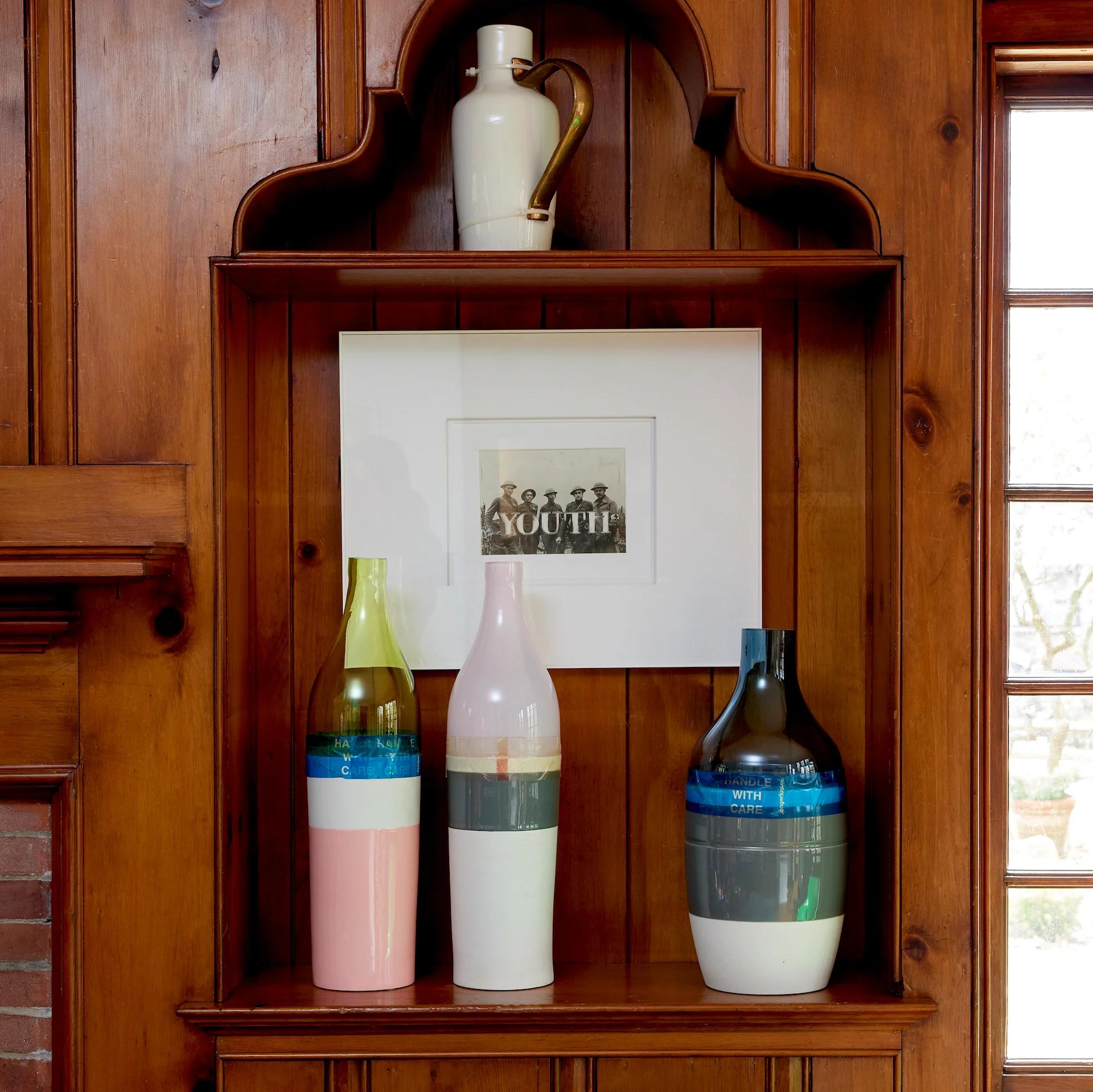
INSIDE MURRAY AND FRANKLIN'S HOME: LONG NECK AND GROOVE BOTTLES BY HELLA JONGERIUS, 2000
Photo © Erin Williams for Design Miami/
Hella Jongerius: Founder of Jongeriuslab, Designer represented by MOSS
At the start of my career, Murray Moss believed in me and generously visited me over and over again—which proved to be life-changing. The many design sessions we did together were about finding the right angle of an idea or object and working with the best craft people in the world—always mixed with lots of laughter as we shared hysterical ideas. Being around his superb eye for quality and innovative way of placing objects felt like attending an inspiring masterclass.
Humberto Campana: Founder of Estudio Campana, Designer represented by MOSS
The Moss gallery to me means inspiration, knowledge, and fantasy. Once, for a collaboration that we were working on, Murray and Franklin put us up at the famous Chelsea Hotel—in order to contaminate us with the crazy atmosphere of New York from the 60s and 70s. It was fantastic!
Laurene Leon Boym: Artist-Designer, Represented by MOSS
Murray scoured the globe constantly for one-of-a-kind design pieces to create a world-class design emporium and gallery. An erudite connoisseur, he possessed a curator’s ability to make connections between objects, staged them beautifully, and mounted some powerful and memorable exhibitions.
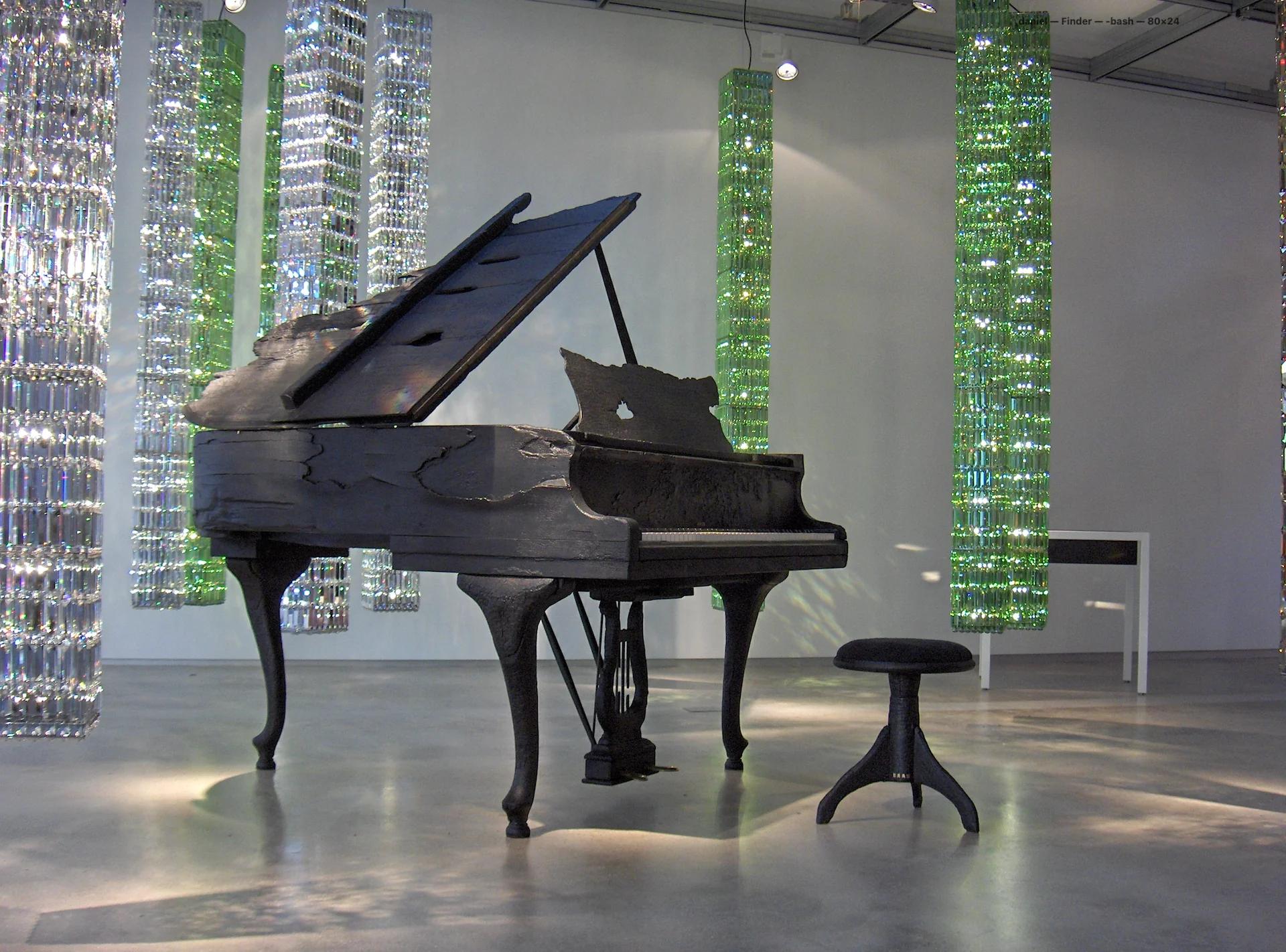
MAARTEN BAAS' BABY GRANDE FLAMBE AT THE OPENING OF MOSS LA IN 2007
Photo © Franklin Getchell
Maarten Baas: Artist-Designer, Represented by MOSS
The first time I met Murray was in 2004 in Paris. I had graduated with my Smoke series, and he invited me to do a solo exhibition based on that. In order to get the collection to New York in time, the transport date would need to be two months after this first meeting. I didn’t say yes right away as I seriously considered the practical and conceptual issues. But once I went for it, the whole MOSS machine started working for me. They immediately forwarded me a working budget and ordered the 25 pieces I selected to use in the collection.
Presented during ICFF in May 2004, Where There’s Smoke... became an iconic exhibition that many people still remember. Only years afterwards could I see the enormous risk that MOSS took trusting a 25-year-old kid. They invested a lot to help me deliver a solo show within 2 months. There was no back-up plan; the show was going to be at the most important moment of the year. To say this was a stepping stone for me, would not justify the value. It was more like a space shuttle launch platform. And a great first result of a beautiful collaboration.
One piece of advice that Murray gave has stuck, so simple and versatile: “Do what you need to do, and do it as well as you can.” This was the right sentence I needed to get over hesitations and just kick some ass in the world of design and art. Exactly how MOSS did it too.
I haven’t ever had a comparable collaboration with anyone else. Which is weird, since it was the very first of my career. This has also made me cautious, having heard so many bad stories where young artists are picked up by mala fide agents in the art world. But Murray and Franklin never let me down; they were always fair and embraced me as if I was their son. Even today, when I call Murray, I’m impressed by his vision, his ideas, and his creative way of dealing with things. And I have to mention the big laughs that we always had and have when we talk with each other. I will be forever grateful to them, and I hope I could fulfill a bit of what they expected from me.

PHILIPPE STARK SIGNING HIS GUN LAMPS AT MOSS IN 2005
Photo © Franklin Getchell
Sarah Natkins: Design Communications Specialist
Few people can mesmerize you with the story of a design’s genesis—where its concept, craft, and material merges with an obscure technique, personality, or moment—like Murray. A few hours before Moss’s off-site exhibition for the first Design Miami/ was set to open in 2005, Murray spent what felt like a full hour taking me down this exquisite rabbit hole, going through every detail of the show, from Tord Boontje to Hella Jongerius. While an army swirled around us putting the finishing touches on the installation, time stood still, and I felt like I was Alice in Wonderland with the brilliant, beautiful Mad Hatter. ◆
